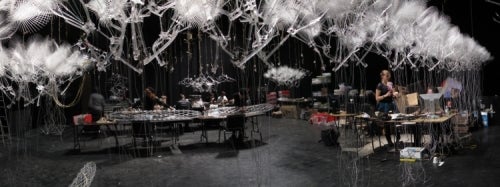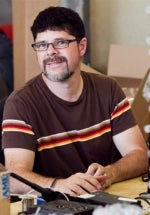
At the intersection of art and architecture a KI prof helps prepare young minds for the future
Today, the term “Renaissance Man" is tossed around so casually that it has lost much of its import. Knowledge Integration Professor Rob Gorbet doesn’t necessarily like the term either (especially when used to describe himself), but he does recognize that in an era of rapidly expanding knowledge, there is the need for (ahem) a renaissance of creative cross-boundary thinking.
It is that attitude that sparked a creative collaboration between Gorbet, an engineer by training, and experimental Canadian architect Philip Beesley. “What would it be like if buildings could care for us?” That was the kind of big question Beesley wanted to explore, and he needed Gorbet’s technical expertise and pluridisciplinary perspective to help make that happen.
With TED Fellow and key collaborator Rachel Armstrong plus dozens of others, the two created an immersive installation combining physics, chemistry, sculpture, biology, materials science, engineering and robotics in a combination not imagined before. Named Hylozoic Ground, the work is a kinetic synthetic jungle with translucent “branches and leaves” that react to those passing through the exhibit.
The installation took the art and architectural world by storm, and was selected to represent Canada at the Venice Biennale of Architecture. “Kind of like the Olympics of architecture,” according to Gorbet. From there, further exhibits were erected around the world, including the three-storey high Hylozoic Veil at The Leonardo art and science museum in Salt Lake City, Utah.
Through its boundary-busting creativity, the exhibit, and Gorbet’s work caught the attention of US educational designer Lucinda Presley, who identified an opportunity to use the exhibit as an advanced learning tool for a new generation of thinkers.
The SSHRC-supported Beesley Education Project was founded, with curriculum where students invent their own creative devices using the same shape memory alloy (muscle wire) that allows the Hylozoic Veil to behave and react organically.

Gorbet and Presley worked with grade 7 classes in Palestine and grade fives in Salt Lake City Utah, and hope to bring the project to a local school in the fall. Making connections between art, science and invention was a hit with the students: “I love doing science this way!” was one typical comment.
Next up, Gorbet took his unique educational perspective to Mesa Arizona, where he applied the same principles to help a local museum redefine itself for the future. “People like Leonardo (da Vinci) were engineers and artists and scientists all in the same person,” he told a local Arizona newspaper covering the launch of the i.d.e.a. Museum.
The explosion of human knowledge that accompanied the Industrial Revolution created the need for specialists, Gorbet said. “The Knowledge Integration program arose as a kind of response to what we see as the over-specialization of university education. Information is ubiquitous today, and the important thing is to teach students how to find, filter, connect, and apply all that information to make real change in the world. This is what KI was designed to do.”